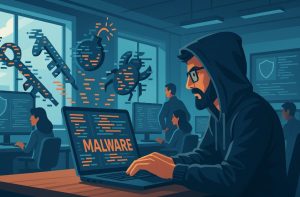
Have you ever wondered how cyber attackers manage to breach sophisticated security systems despite the most advanced defences? The answer lies in understanding how attacks unfold, step by step. This is where the Cyber Kill Chain becomes a vital framework in the field of cybersecurity.
The Cyber Kill Chain is an adaptation of the military’s original “kill chain” model, which describes a series of actions to identify and neutralise an enemy target. In 2011, Lockheed Martin adapted this concept to the digital battlefield, creating a methodical process to understand, detect, and disrupt cyber attacks.
This framework breaks down a cyber attack into distinct stages, from the initial planning to the execution of malicious actions. By identifying each stage, cybersecurity teams can detect potential breaches earlier and respond more effectively.
The Cyber Kill Chain is especially useful in combating Advanced Persistent Threats (APTs), prolonged, targeted attacks where adversaries spend significant time planning, surveilling, and exploiting vulnerabilities.
Today, organisations use the Cyber Kill Chain not just to understand how cyber attacks occur but also to design stronger defences and incident response strategies.
How Did the Cyber Kill Chain Evolve from Military Strategy to Cyber Defence?

The concept of a kill chain originated in the military, where it was used to describe the process of identifying a target, dispatching forces, and executing an operation. Lockheed Martin’s Cyber Kill Chain takes this structure and applies it to cybersecurity, outlining the attacker’s path from reconnaissance to data theft or system compromise.
Initially designed to address sophisticated malware-based threats, the Cyber Kill Chain provided a framework to anticipate attacker movements and deploy countermeasures in time.
However, since its introduction in 2011, the cybersecurity landscape has transformed significantly. The emergence of cloud computing, mobile devices, remote work, and artificial intelligence has increased both the complexity and the scale of attacks.
In response, many experts have adapted the original model, adding new phases, such as monetisation, and incorporating technologies like threat intelligence, machine learning, and behavioural analytics to detect and mitigate modern threats.
The Cyber Kill Chain remains a foundational tool because it provides a structured view of cyber attack progression, helping organisations build layered defences that address vulnerabilities at every stage.
What Are the Eight Phases of the Cyber Kill Chain?
The original Lockheed Martin Cyber Kill Chain included seven stages. Over time, cybersecurity professionals have added an eighth phase, recognising that attackers now seek to monetise their operations. Understanding each stage in detail is crucial to intercepting an attack at its earliest point.
1. Reconnaissance – How Do Attackers Identify Targets?

The first stage of any cyber attack involves reconnaissance, where the attacker gathers intelligence about their intended target. This may include collecting employee information from social media, scanning for open ports, exploring public-facing servers, or identifying outdated software.
For example, a cybercriminal planning to target a financial institution may begin by researching employee email formats and scanning the company’s web applications for known vulnerabilities. The more information an attacker collects, the more personalised and convincing their intrusion attempts will be.
Detecting reconnaissance activities early, such as suspicious scanning or repeated login attempts, can help organisations prevent the attack before it begins.
2. Weaponisation – How Do Attackers Build Their Tools?

Once sufficient data has been gathered, the attacker moves on to weaponisation. This phase involves developing malicious tools to exploit identified weaknesses. These could include malware, ransomware, Trojans, or worms tailored to take advantage of the specific vulnerabilities discovered earlier.
For instance, an attacker may craft a malicious attachment designed to exploit a flaw in a widely used document reader or create a phishing link that redirects users to a fake login portal. Attackers may also set up backdoors that allow them to regain access even if the original entry point is discovered and closed.
At this stage, defenders can use threat intelligence platforms to identify known malicious payloads or suspicious code patterns before deployment.
3. Delivery – How Is the Attack Launched?

In the delivery phase, the attacker transmits the weaponised payload to the target. This can occur through phishing emails, malicious links, compromised websites, or removable media such as USB drives.
Modern attacks often combine multiple techniques. For example, a cybercriminal might send a legitimate-looking invoice via email that, when opened, triggers a hidden script to download malware from a remote server.
Social engineering remains one of the most common delivery tactics, as it exploits human trust rather than technical weaknesses. To defend against this stage, organisations must invest in email filtering, web gateway security, and employee awareness training.
4. Exploitation – What Happens When the System Is Compromised?

During the exploitation phase, the malicious code is executed. This typically happens when a user interacts with the malicious file or link, unknowingly allowing the attacker to exploit a vulnerability in the system.
For example, an employee might enable macros in a spreadsheet received from a seemingly trusted source, which then runs hidden code to compromise the computer. This stage is often the point of no return, once exploitation occurs, the attacker gains partial control.
Mitigation here relies on timely patching, system hardening, and endpoint protection solutions to stop known exploits from succeeding.
5. Installation – How Do Attackers Establish a Foothold?

After exploitation, the attacker installs malware or other tools that allow persistent access. This could involve altering system configurations, adding new user accounts, or embedding code that reinstalls itself after reboots.
At this point, the attacker effectively “owns” part of the system. They may install rootkits or spyware to monitor user activity or use command-line scripts to maintain control covertly. Network monitoring and regular security audits can detect abnormal system changes indicative of installation activities.
6. Command and Control (C2) – How Do Attackers Maintain Communication?

In the command and control (C2) phase, the attacker connects to the compromised system remotely. They establish channels to issue commands, transfer data, or move laterally through the network.
C2 communications are often encrypted and disguised to blend in with legitimate network traffic. Attackers might use social media platforms, cloud services, or even public forums to manage communications with infected hosts.
Security teams must implement anomaly detection and network segmentation to isolate suspicious traffic and block outbound connections to untrusted destinations.
7. Actions on Objectives – What Are Attackers’ End Goals?

The actions on objectives phase is where attackers execute their primary intent. This may include stealing sensitive data, encrypting files for ransom, or sabotaging systems to disrupt operations.
A common example is a ransomware attack where, after months of infiltration and data collection, the attacker encrypts an organisation’s critical files and demands payment for decryption keys.
In other cases, attackers may exfiltrate data quietly, selling it later on dark web marketplaces. Responding effectively at this stage requires a strong incident response plan and data backup strategy to minimise impact.
8. Monetisation – How Do Attackers Profit from Their Attacks?

The monetisation phase is a relatively new addition that reflects the financial motives behind most cyber attacks. After obtaining data or control, attackers seek to generate income, either through ransom demands, cryptocurrency theft, or selling stolen credentials.
For example, following a large-scale healthcare breach, attackers might sell patient records to identity thieves or use them for targeted scams. Preventing attacks from reaching this stage is crucial, as financial recovery is often costly and reputational damage long-lasting.
How Is the Cyber Kill Chain Adapting to Modern Threats?
The cyber threat landscape has evolved drastically since 2011. Attackers today are far more agile, often automating or merging several stages of the Cyber Kill Chain to reduce the time defenders have to react.
With the introduction of artificial intelligence (AI), threat actors can launch sophisticated attacks that adapt in real time. According to the CrowdStrike 2025 Threat Hunting Report, adversaries are increasingly weaponising AI to enhance phishing, malware obfuscation, and data analysis.
Defenders must respond by integrating AI-driven security analytics, threat intelligence, and zero-trust architectures to counter these emerging threats. This evolution highlights the importance of continuously updating the Cyber Kill Chain framework to reflect new realities.
What Are the Critiques and Limitations of the Cyber Kill Chain?

While the Cyber Kill Chain remains a valuable framework, it has several recognised limitations. One major critique is that it focuses primarily on perimeter-based attacks, those originating outside an organisation.
In a world dominated by cloud environments and remote work, many breaches occur internally or through compromised credentials, which the traditional model does not fully address.
Another concern is that the framework may fail to detect insider threats or web-based exploits such as Cross-Site Scripting (XSS), SQL Injection, or Zero-Day attacks. The 2017 Equifax breach, caused by a web application vulnerability, is a well-documented example of how the kill chain may not capture every type of attack vector.
Furthermore, as the Cyber Kill Chain is now widely known, sophisticated attackers understand its structure and sometimes alter their strategies, skipping or blending stages to avoid detection. This makes traditional linear defence strategies less effective.
Despite these critiques, the model continues to offer foundational value by encouraging structured thinking, detection, and prevention across all stages of a cyber attack.
How Can Organisations Apply the Cyber Kill Chain to Strengthen Defences?
To remain effective, the Cyber Kill Chain should be integrated with other frameworks like MITRE ATT&CK and the NIST Cybersecurity Framework. This combination enhances visibility across both tactical and strategic levels.
The table below outlines how each phase of the kill chain aligns with typical defensive actions:
| Cyber Kill Chain Phase | Defensive Strategy |
| Reconnaissance | Monitor for network scans and unusual login attempts. |
| Weaponisation | Use advanced malware analysis and threat intelligence. |
| Delivery | Implement robust email and web content filters. |
| Exploitation | Regularly patch software and enforce system hardening. |
| Installation | Deploy endpoint detection and response (EDR) tools. |
| Command & Control | Monitor outbound traffic and isolate anomalies. |
| Actions on Objectives | Maintain regular backups and incident response plans. |
| Monetisation | Implement data loss prevention (DLP) and fraud monitoring. |
This approach ensures that every phase of the attack lifecycle is covered, reducing the chances of escalation and long-term compromise.
Conclusion
As cybersecurity threats continue to evolve, the Cyber Kill Chain is likely to transform from a linear process into a dynamic, intelligence-driven model. The future lies in automation, predictive analytics, and real-time detection using machine learning.
Modern cybersecurity teams are already shifting towards adaptive defence mechanisms that respond to changing attacker behaviour instantly. In essence, the future Cyber Kill Chain will not just describe how attacks occur, it will actively shape how organisations prevent them.
FAQs
What is the main goal of the Cyber Kill Chain?
Its goal is to identify and interrupt cyber attacks at different stages before they cause significant damage.
Who developed the Cyber Kill Chain model?
It was developed by Lockheed Martin in 2011 as part of its Intelligence-Driven Defence strategy.
Is the Cyber Kill Chain still relevant in modern cybersecurity?
Yes, although it needs adaptation for modern cloud and AI-driven environments.
Can the Cyber Kill Chain detect insider threats?
Not entirely; it is most effective against external attacks. Insider threat detection requires behavioural analytics and access monitoring.
What is the difference between the Cyber Kill Chain and MITRE ATT&CK?
MITRE ATT&CK focuses on specific attacker techniques and behaviours, while the Cyber Kill Chain explains the overall attack progression.
How can small businesses use the Cyber Kill Chain?
By understanding each stage, small businesses can implement early detection tools, regular updates, and employee awareness training.
Why is early detection so important in the Cyber Kill Chain?
Because the earlier an organisation interrupts the attack, the less damage, downtime, and financial loss it will experience.